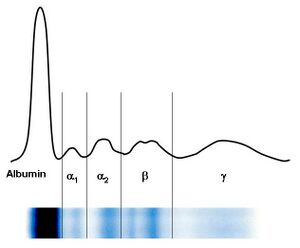| Protein
Relative molecular weight
|
Serum
concentration [g/l]
|
Half -life
[days]
|
Function
|
|
|
|
Prealbumin
(Transthyretin)
54,000
|
0.2–0.4
|
2
|
|
↓ malnourished
|
| Albumin
68,000
|
35–53
|
15–19
|
- the most important transport protein
- maintenance of colloid-osmotic pressure
- protein reserve of the organism
|
↓ catabolism
↓ hepatopathy
↓ protein losses
|
| α 1
area
|
α 1 -lipoprotein
180,000–360,000
|
1.0–1.6
(Apo AI)
|
|
- high density lipoprotein (HDL)
- transport of cholesterol to the liver
|
|
| α 1 -antitrypsin
(α 1 -protease inhibitor)
54,000
|
0.9–2.0
|
4
|
- inhibitor of lysosomal proteases (mainly elastase from polymorphonuclear leukocytes)
- congenital deficiency can be the cause of lung disease (emphysema) and liver disease (cirrhosis)
|
↑ acute inflammation
|
| α 1 -acid glycoprotein
( orosomucoid )
40,000
|
0.5–1.2
|
5
|
- binding of lipophilic substances (e.g. progesterone and some drugs)
- participates in the regulation of the immune response
|
↑ inflammation
|
| α 1 -fetoprotein
69,000
|
< 7.5 μg/l
|
3.5
|
- physiologically produced by the fetal liver and yolk sac
- major protein of fetal serum
- physiologically present in the serum of pregnant women
|
↑ hepatoma
↑ some GIT malignancies
↑ pregnancy
|
| α 2
area
|
Haptoglobin
85,000–1,000,000
|
0.3–2.0
|
2
|
|
↑ acute inflammation
↓ hepatopathy
↓ intravascular hemolysis (haptoglobin consumption)
|
| α 2 -macroglobulin
800,000
|
1.3-3.0
|
5
|
- protease inhibitor (thrombin, trypsin, chymotrypsin, pepsin)
- transport of small proteins ( cytokines , growth factors) and divalent ions (e.g. Zn 2+ )
- thanks to its very high molecular weight, it does not even pass through a damaged glomerular membrane
|
↑ acute inflammation
|
| Ceruloplasmin
160,000
|
0.2–0.6
|
4.5
|
- redox activity (oxidation of Fe 2+ to Fe 3+ )
- copper binding (binds up to 90% Cu in serum)
|
↓ Wilson's disease (hepatolenticular degeneration)
|
| β 1 area
|
Transferrin
77,000
|
2.0-3.6
|
7
|
- transport and uptake of free iron
|
↑ iron deficiency
↓ malnutrition
↓ hepatopathy
↓ inflammation
|
| Hemopexin
57,000
|
0.5–1.1
|
3–7
|
|
|
| β-lipoprotein
2,750,000
|
0.7–0.9
(Apo B-100)
|
3
|
- low density lipoprotein (LDL)
- cholesterol transport to cells
- very high molecular weight
|
|
| C4 component of complement
206,000
|
0.1–0.4
|
1
|
|
↑ inflammation
↓ autoimmune conditions
|
| β 2 area
|
C3 component of complement
180,000
|
0.8–1.4
|
1
|
|
↑ inflammation
↓ autoimmune conditions
|
| β 2 -microglobulin
11,800
|
0.001–0.002
|
|
- component of leukocyte antigens
|
↑ hematological tumors
↓ tubular resorption disorder
|
| Fibrinogen
340,000
|
1.5–4.5
|
|
- part of the coagulation cascade, precursor of fibrin
- physiologically only in plasma, not in serum
|
↑ inflammation
|
| C-reactive protein
111,000
|
1.5–5 mg/l
|
1
|
|
↑ acute inflammation (bacterial)
|
| γ region
|
IgG
150,000
|
8.0-18.0
|
24
|
|
↑ (chronic) inflammation
|
| IgA
160,000
|
0.9–3.0
|
6
|
- mucosal immunity antibodies
|
↑ inflammation of mucous membranes and liver
|
| IgM
900,000
|
0.6–2.5
|
5
|
|
↑ acute inflammation
|

